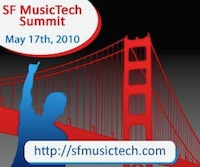- If you are in a band and you have a CD – read SoundExchanges New Artist Checklist. Make sure you are registered with SoundExchange, otherwise you are just leaving money on the table.
- Submit your music to Pandora, AccRadio, Last.fm – these audiences are growing as consumers continue to demand personalization and control that terrestrial radio is not providing. In the future, Pandora will also unveil a “Pandora for artists” where the principal focus will translate what goes on with artists into something of value for the audience. For example, you could give a song a thumbs up and then Pandora could let you know that band is actually playing in your area on XYZ date.
- Viral videos are one of the most exciting things happening in music right now. YouTube allows artists to collaborate over space and time. One of the beautiful things about YouTube videos is that they are usually not so edited. They provide a record of an event. An amazing example is Pomplamoose Music who just bought a house from their record sales all developed through their YouTube channel.
- Ben Folds is super rad. When asked how artists would interact with even newer technologies he simply said “I don’t know”, followed closely by my personal favorite quote of the day “10 years ago we all seemed to know what was coming next and that is why it came to an end.”
- Cisco Media Solutions Group has a new artist website platform called Eos which Warner Music Group is rolling out with their artists (currently 35 sites launched to date). Ryan Garner from Warner admitted that in the past artist websites where primarily a new album promo tool that died quickly after and album was released. The next phase of artist website is built to last and become its own meaningful channel. Warner partnered with Cisco so they didn’t have to try to reinvent the technology wheel that Cisco had already mastered. Best piece of take away from Garner was that fans what to “feel like the artist goes to their website”. They achieved this by building in an easy system for artists to upload mobile phone photos, videos, tweets – making that fresh, straight from the artist content front and center. Focusing on actual two way conversations between artist and fan.
- Pledge Music is a new platform that provides fans and artists the opportunity to work together to make new records and raise money for charity. Unlike similar platforms, founder Benji Rogers councils bands to “never ask fans for money”, instead tell them why this is the best way for them to be involved with your music. Currently fans spend an average of $92 in pledges. Utilizing a platform like this is another way to compete with the fact that essentially all music is already free (so you are adding value with you engage the fan in the process of making the music and also involve a meaningful charity).
- Music Hack Day is happening all over the word. The one in San Francisco resulted in 35 apps created in 24 hrs. The party favorite has got to be Six Degrees of Black Sabbath.
- I had no idea there was a top level .music domain name “initiative” but you can sign the petition at their website - http://www.music.us/
- Next Big Sound is doing truly insane things with artist data and right now you can check out their new premier service for free here. If you are artist, you NEED to be using this service. The premier service with allow you to view social music data alongside traditional sales/radio data, traffic to an artist's website Google Analytics, press mentions, blog mentions, live performances, and chart appearances. All in one place. Umm – yes please.
- If you don’t own an iPhone or an iPad, do not go to a tech conference in San Francisco. Lucky for me I just purchased my first iPhone a few weeks ago so I was all good, but seriously, Apple owned the room.
PS. Bonus buzz word = freemium
Freemium is a business model that works by offering basic Web services, or a basic downloadable digital product, for free, while charging a premium for advanced or special features. The word "freemium" is a portmanteau created by combining the two aspects of the business model: "free" and "premium". The business model has gained popularity with Web 2.0 companies.
